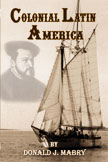© 2001 Donald J. Mabry
Ocean transportation
The Spanish used a convoy system for 200 years. There was the fleet (flota) system was between Seville, Spain and Vera Cruz, Mexico. The galleons ran from Seville to the north coast of South America. Both touched at the Canary Islands. There also was a galleon that did the Acapulco-Manila route. These convoys were headed by the admirals ship and trailed by the vice-admiral's ship. Legally, the tonnage ranged from 80 to 550 tons but the ships were invariably overloaded. To cross the Atlantic took 40 days; the Manila-Acapulco run took seven months. It was necessary to protect the treasure ships going to Spain and the merchant ships going both ways from privateers, pirates, and other marauders. the Spanish only lost two fleets to enemies during the 200-year history of the system. More were lost to storms. In the late colonial period, the Crown allowed individual ships to sail.
Portage
Most portage was done by humans. This was particularly true in areas with large numbers of Amerinds. This cheap labor could carry a surprising amount of cargo.
Draft Animals
Mules and oxen were very expensive so their use was more specialized. In old Panama in the 17th century, there were 33 owners of pack trains with a total of 850 mules. Using mules and hiring arrieros (muleteers) was profitable because they were used to transport goods across the Isthmus of Panama so they could be transshipped to Peru and points south. Similarly, mule trains were used between Veracruz and Mexico City and between Mexico City and outlying mines.
In Argentina, goods were transported from the northwest across the pampas to Buenos Aires in oxen-drawn carretas. These carts had two solid, spokeless wheels. They were called chirriones because of the shrill, rasping squeal of the tortured axles. The axles were only greased by the occasional application of animal fat. The Tucumán carretas had two wheels which were seven feet in diameter. The wheel hub was seven tenths of a foot across and the axle was ten and half feet long. The axle didn't turn, only the wheels. Four oxen pulled 3750 pounds of cargo plus supplies fir a total of 5,000 pounds. the car was made entirely of wood. A cart could average about 15 miles a day.
You can read aboutother topics in colonial Latin American history by buying and reading
 Colonial Latin America by Don Mabry.
Colonial Latin America by Don Mabry.
Click on the book cover or the title to go to Llumina Press.